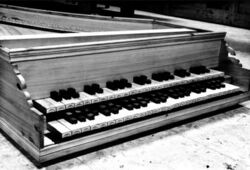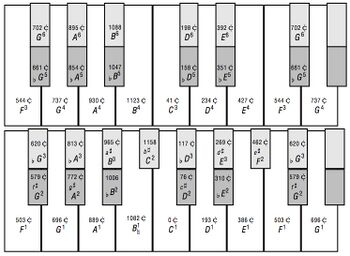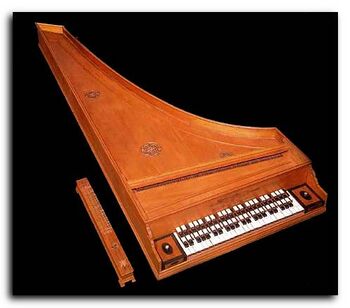Engineering:Archicembalo
The archicembalo /ɑːrkiˈtʃɛmbəloʊ/ (or arcicembalo, /ɑːrtʃiˈtʃɛmbəloʊ/) was a musical instrument described by Nicola Vicentino in 1555. This was a harpsichord built with many extra keys and strings, enabling experimentation in microtonality and just intonation.
Construction
The archicembalo had two manuals, but unlike those on a normal harpsichord these two keyboards were used to provide extra pitches rather than a timbral difference. Both manuals contained all of the usual white and black keys, but in addition each black key was divided into two parts so that a distinction could be made between a sharp or flat note. The lower manual also included black keys between B and C, and between E and F. In total, 36 keys were available in any octave, each of which was tuned to a different pitch, as shown in the diagram of the lower manual.[1]
Tuning
There were two systems of tuning the archicembalo considered by Vicentino:
- The most important was the extended quarter-comma meantone temperament—which, given such a wide gamut of fifths, becomes almost exactly a system of 31 equal divisions of the octave (see 31 equal temperament). This arises because after a cycle of 31 quarter-comma-tempered fifths, the 32nd pitch is remarkably close to a pitch that already exists in the system. Thus, five of Vicentino's 36 possibilities became practically redundant in this system. He suggested that these five be tuned instead according to the second manner described below.
- Vicentino offered an alternative tuning in which the upper keyboard was tuned a quarter-comma higher than the lower, allowing pure fifths by playing chords across the manuals, giving a limited system of triadic just intonation. This tuning still permits modulation to a wide range of keys, but not in a completely circular fashion as with the first tuning described above, and still only modulates by the meantone-tempered fifth, not by the pure fifth.
The observation that extended quarter-comma meantone temperament almost exactly approximates 31 equal was recognized by Huygens in 1661, published in 1691. He says that after making this discovery, he found an earlier mention of the idea in Salinas' report on a 31 tone Italian keyboard, presumably Vicentino's archicembalo.[2]
Vicentino's description of his first tuning has some puzzling statements if it is understood as 31 equal. He says that the major third from C to E is made closer to pure if it uses the slightly lower pitched C on the front keyboard with the slightly higher pitched E from the back keyboard. This is puzzling because in pure 31 equal all the major thirds should have been almost exactly pure already. Karol Berger's analysis of this suggests that he may actually have used a somewhat unequal tuning for his extended meantone system, varying perhaps from 0.2 comma smaller than pure to 1⁄3 comma larger than pure.[3][4]
Uses
Vicentino used his archicembalo to test his own theories of tuning, and realize the more obscure ancient Greek genera, which had been neglected for centuries. In addition to his experiments, he found it very helpful for accompaniment of vocalists and instrumental players, as it was capable of coping with the subtle intonational differences inherent in musical practice in a way that no keyboard instrument had before.
For composers of the time, the archicembalo made total modulatory freedom a possibility without sacrificing the purity of meantone temperament's just thirds as with 12-tone equal temperament. This was exploited by those who learned to play it, such as Luzzasco Luzzaschi. Contemporary composers had been writing vocal music in a very chromatic style for some time, but it was instruments such as the archicembalo that permitted them to explore the instrumental possibilities of chromaticism with a purity of intonation.
Spelling and pronunciation
Vicentino named his instrument the archicembalo[5] with possible reference to Greek prefix ἀρχι-, which means "major, principal" (as in the word architect).[6] Vicentino's advocate Ercole Bottrigari in his Il Desiderio (1599) also used the spelling 'archicembalo'.[7] In most modern English lexica the same instrument has been called arcicembalo (however, without explanation of this non-authentic spelling),[8] while others use Vicentino's spelling,[9] or offer both as alternatives.[10] The spelling 'archicembalo' is preferred in the English translation of the treatise.[11] German music dictionaries consistently give 'archicembalo'[12] as well as the largest Italian Enciclopedia della musica Ricordi.[13] The German scholar Manfred Cordes, who dedicated the book to Vicentino's music system, rebuilt the historic instrument and made a set of 'live' audio recordings using it, gives archicembalo throughout his book.[14] Another German scholar in his article prefers 'arcicembalo', while at the same time pointing out that Vicentino himself used the prefix arci- in another place, to describe an organ with similar functions called an 'arciorgano', and that the Italian language does not make a hard-and-fast distinction between the two forms.[15]
Surviving archicembali
Only one keyboard instrument using his 31-note-to-the-octave system survives from the Renaissance: the "Clavemusicum Omnitonum Modulis Diatonicis Cromaticis et Enarmonicis",[16] built by harpsichord maker Vito Trasuntino of Venice (1526 – after 1606) in 1606 intended to play the diatonic, chromatic and enharmonic melodies (moduli). It is on display at the International museum and library of music in Bologna. The Clavemusicum is accompanied by a tuning device, called TRECTA CORDO, that clearly shows an uneven division of the octave, with the usual meantone temperament for the first row of upper keys with C#, Eb, F#, G# and Bb.
Notes
- ↑ Casimiri II 173 foldout music 28 NB.23. Alternate Exhibit Objects. Library of Congress Vatican Exhibit
- ↑ Cohen, H. F. (11 November 2013). Quantifying Music: The Science of Music at the First Stage of Scientific Revolution 1580–1650. Springer Science & Business Media. p. 222. ISBN 978-94-015-7686-4. https://books.google.com/books?id=WNHoCAAAQBAJ&pg=PA222.
- ↑ Berger, Karol (1980). "Theories of chromatic and Enharmonic Music in Late 16th Century Italy - Chromatic systems (or non-systems) from Vicentino to Monteverdi". Early Music History (UMI Research Press). https://www.academia.edu/291960. "In the same rows [in] which one plays the perfect fifths, there will one find also the major thirds more perfectly tuned than those which we use.". [translated]
- ↑ Lindley, Mark (1990). "An Historical Survey of Meantone Temperaments to 1620". Early Keyboard Journal 8. https://www.academia.edu/643252. "It is often said that Nicola Vicentino divided the octave into 31 equal parts on his archicembalo and arciorgano. This is dubious. The claim is made in behalf of the first of the two tunings he prescribed for his archicembalo in 1555. It is true that the 31 division virtually matches 1/4-comma meantone temperament (the major thirds differing by less than a cent), and that Vicentino said that parts of his first tuning matched the normal practice of good masters. He also said, however, that some of the major thirds in his other tuning were 'more perfectly tuned than those which we use', and this is hardly compatible with a reading that would require the major thirds in the first tuning to have been virtually pure. The advocates of that reading have been obliged to say that, 'Part of Vicentino's system does not seem to make sense' and that his own microtonal compositions are full of mistakes. Vicentino's first tuning may nonetheless be considered an irregular variant of Template:Citefrac-comma meantone temperament, inasmuch as his 31 'dieses' (so he called them) had to average 1/31-octave and he said that, 'from every key [of the keyboard] no consonance is lacking'.".[page needed]
- ↑ In L'antica mvsica ridotta alla moderna prattica (Roma, 1555): il nostro instrumento, detto Archicembalo (f.11v), nel trattato del quinto libro sopra lo stormento, da me detto Archicembalo (f.16v), come è l'Archicembalo nostro (f.17v). For more authentic entries of 'archicembalo' see the digitalizated version of the Vicentino's treatise at Thesaurus musicarum italicarum .
- ↑ As in the article "Archicembalo (ital. Erzchembalo)" found in Riemann Musiklexikon. 12th revised edition. Sachteil. Mainz, 1967, S.49;
- ↑ Bottrigari, Il Desiderio.
- ↑ As e.g. in the article "Arcicembalo, arciorgano", in: Harvard Dictionary of Music. Second edition revised and enlarged by Willi Apel. Cambridge, Massachusetts: Harvard University Press, 1969, p.48 (and in all later reprints); Oxford Companion to Music, ed. by Alison Latham. Oxford: Oxford University Press, 2002, p.58; in Henry W. Kaufmann and Robert L. Kendrick, "Nicola Vicentino", The New Grove Dictionary of Music and Musicians, second edition, edited by Stanley Sadie and John Tyrrell. London: Macmillan Publishers 2001. Accessed online at www.oxfordmusiconline.com; Lorenzo Bianconi. "Gesualdo, Carlo, Prince of Venosa, Count of Conza", The New Grove Dictionary of Music and Musicians, second edition, edited by Stanley Sadie and John Tyrrell. London: Macmillan Publishers, 2001; and Sibyl Marcuse, Musical Instruments: A Comprehensive Dictionary, corrected edition. New York: W. W. Norton & Company, Inc., 1975, p.80.
- ↑ Edmond Strainchamps, "Luzzaschi, Luzzasco", The New Grove Dictionary of Music and Musicians, second edition, edited by Stanley Sadie and John Tyrrell. London: Macmillan Publishers, 2001; Henry W. Kaufmann, "More on the Tuning of the Archicembalo", Journal of the American Musicological Society 23 (1970), pp.84–94.
- ↑ Edwin M. Ripin. "Arcicembalo [archicembalo]". The New Grove Dictionary of Music and Musicians, second edition, edited by Stanley Sadie and John Tyrrell. London: Macmillan Publishers, 2001.
- ↑ Ancient Music Adapted to Modern Practice. Translated, with introduction and notes, by Maria Rika Maniates. Edited by Claude V. Palisca. New Haven and London: Yale University Press, 1996 (for numerous entries of [English] usage 'archicembalo' in this book see the index on p.475).
- ↑ (1) "Die Musik in Geschichte und Gegenwart". Allgemeine Enzyklopädie der Musik. Bd.3. Kassel: Bärenreiter-Verlag, 1954, Sp.415 u.a.O. (2)-Riemann MusikLexikon. 2nd completely revised edition. Sachteil. Mainz, 1967, S.49; ib., Personenteil L-Z. Mainz, 1961, S.849; (3)-Brockhaus Riemann Musiklexikon. Vol.1. Mainz: Schott; Munich: Piper, 1995, S.51; (4) Peter Niedermuller, "Vicentino". In: Die Musik in Geschichte und Gegenwart. Allgemeine Enzyklopädie der Musik. 2nd ed. Personenteil. Vol.16. Kassel, Basel, 2006, pp. 1540–1543.
- ↑ Enciclopedia della musica Ricordi. Vol.1 Milan: Rizzoli Editore, 1972, pp.115–116; Vol.2. Milan: Rizzoli Editore, 1972, p.122; Vol.6. Milan: Rizzoli Editore, 1972, p.318.
- ↑ Cordes, M. Nicola Vicentinos Enharmonik. Musik mit 31 Tönen. Graz, 2007. Contains CD with complete music examples of 'enharmonic' genus found in the Vicentino's treatise.
- ↑ Volker Rippe, "Nicola Vicentino—Sein Tonsystem und seine Instrumente. Versuch einer Erklärung", Die Musikforschung 34 (1981), pp.393–412. Citation on pp.397–398; see also Dizionario Garzanti della lingua italiana, Milan: Garzanti Editore, 1963, entries "archi-" and "arci-".
- ↑ "See the original inscription at" (JPG). http://www.bolognawelcome.com/imageserver/gallery_big/files/Luoghi/Musei/MuseoMusica/Trasuntino.jpg.
References
- Alves, Bill, "The Just Intonation System of Nicola Vicentino", 1/1: Journal of the Just Intonation Network 5, No. 2 (Spring 1989), pp. 8–13. Bill Alves - The Just Intonation System of Nicola Vicentino
- Kaufmann, Henry W., "More on the Tuning of the Archicembalo", Journal of the American Musicological Society 23 (Spring 1970), pp.-84–94.
- Pio, Stefano, Viol and Lute Makers of Venice 1490–1630/Liuteria Veneziana 1490-1630, English translation by Marina De Marchi and Robert Schoen. Venice: Venice Research, 2011. ISBN:9788897039617. www.veniceresearch.com
External links
- Lower manual plan. Casimiri II 173 foldout music 28 NB.23. Alternate Exhibit Objects. Library of Congress Vatican Exhibit
- The Archicembalo of Nicola Vincentino (pdf - 2.4mb) Marco Tiella. The English Harpsichord vol.1, nr. 5 (1975)
- Musical Experience gained through Working with the Archicembalo Reconstruction (pdf - 1.5mb) Marco Tiella. International Conference in Musicology, Kraków (2003)
- Margo Schulter on Vicentino's keyboards
- Clavemunicum omnitonum modulis diatonicis cromaticis et enearmonicis (Vito Trasuntino - 1609) on display at the International museum and library of music of Bologna
 |




